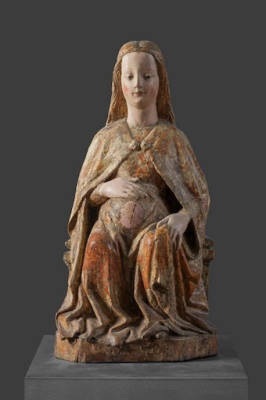Gospel in Art: The mother of my Lord

Seated Expectant Virgin Mary (Maria Gravida), Anonymous sculptor, Bohemia, 1430-1440 © National Gallery, Prague
Source: Christian Art
Gospel of 22 December 2024
Luke 1:39-45
In those days Mary arose and went with haste into the hill country, to a town in Judah, and she entered the house of Zechariah and greeted Elizabeth. And when Elizabeth heard the greeting of Mary, the baby leaped in her womb. And Elizabeth was filled with the Holy Spirit, and she exclaimed with a loud cry, 'Blessed are you among women, and blessed is the fruit of your womb! And why is this granted to me that the mother of my Lord should come to me? For behold, when the sound of your greeting came to my ears, the baby in my womb leaped for joy. And blessed is she who believed that there would be a fulfilment of what was spoken to her from the Lord.'
Reflection on the sculpture
Today's Gospel reading is a repetition of yesterday's, as once again we hear Luke's account of the Visitation. The fact that the Church presents this passage to us two days in a row highlights its significance. Today I want to concentrate on a different aspect of our reading.
In our Gospel reading, Elizabeth greets Mary with the beautiful title, 'the mother of my Lord'. It is a profound way to honour Mary, though we do not hear this title as often. Each of us can also call Mary 'the mother of my Lord', recognising her unique role in bringing Christ to the world. To refer to Mary in this way is closely linked to calling her 'the mother of God', as both titles affirm the divinity of Jesus. The term 'Lord' emphasises the personal relationship we are invited to have with Christ. It reminds me of the words of Thomas the Apostle in John's Gospel, who, after doubting, made a deeply personal confession of faith to the risen Christ: 'My Lord and my God.' For each of us, Jesus is not just Lord in a general sense; he is 'MY Lord'.
Our early 15th century sculpture portrays a highly pregnant Virgin Mary, a type of depiction known as Maria Gravida. This theme, focusing on the expectant Virgin, was particularly popular in female convents, where it was often paired with freestanding sculptures of the Infant Jesus. The worship of the Christ Child was closely tied to the veneration of Mary as the Mother of God. This devotion was fuelled by new religious texts detailing her life and mystical visions reported by nuns, especially in South-German convents, where this sculpture originates from. The present sculpture, showing a seated Virgin, may have been part of a small altarpiece or a standalone devotional object, likely used during the Advent season. Mary's pregnancy is emphasised as she gestures towards her rounded belly, drawing attention to the miraculous nature of her expectancy. This is further highlighted by a now very faint faint medallion depicting the Infant Jesus carrying the cross, a subtle foreshadowing of his future Passion. While much of the original polychromy and decoration has been lost, traces remain. The hems of Mary's open mantle were once gilded and adorned with delicate punched patterns, impressed into a chalk base overlaid with golden sheets.
LINKS
Gospel in Art: https://christian.art/
Today's Reflection: https://christian.art/daily-gospel-reading/luke-1-39-45-2024-2/


















